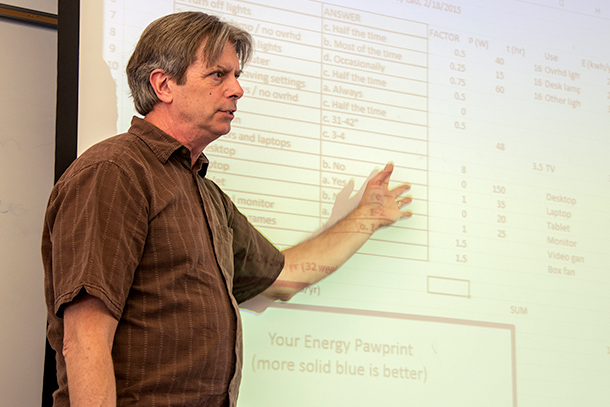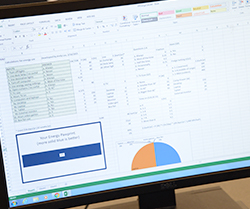
Associate Professor Andrew Lau explains how students can determine their Penn State PawPrint by using a Microsoft Excel energy calculator he designed. Lau developed the calculator to help students better understand their ecological impact on the University Park campus.
Creating a greener future - one PawPrint at a time
Student-centered sustainability project focuses on reducing ecological footprint
05/23/17
UNIVERSITY PARK, Pa. - The PawPrint, a student-centered sustainability metric, helps students at Penn State’s University Park campus understand how they can behave more sustainably by making better day-to-day choices.
Funded by Penn State’s Sustainability Institute’s Reinvention Fund, the PawPrint project estimates that it is possible to reduce one’s ecological footprint by up to two-thirds by simply re-evaluating daily choices and making sustainable changes to day-to-day activities. An ecological footprint is defined as the amount of land and sea area it takes to provide a person’s resources and to assimilate their wastes.
Right now, Earth’s biocapacity, the on-going supply of renewable resources Earth can provide, is equivalent to 1.8 global hectares (gha) per person if divided up evenly among the 7.5 billion people of Earth. The United State’s global ecological footprint is equivalent to 2.7 gha per capita – a measurement that exceeds what the earth can provide by 50 percent. If every country’s global ecological footprint was comparable to the United State’s, it would take five Earths to sustain this lifestyle.
Andrew Lau, associate professor of engineering design, believes that in order for students to make better choices and lessen their ecological footprint, they need to be more informed about the opportunities they have and the effects their choices can make.
“Students generally want to be good stewards of Earth. It’s difficult though, to make good decisions because the environmental impact of a product or choice is not easily determined. Ecological Footprint provides that in a single measure, leading to better-informed choices,” he said.
A number of online ecological footprint estimators are available to determine a person’s impact on the environment, but college students often find the questions asked by the estimators don’t apply to their lives in dorms or apartments much.
The PawPrint aims to change that.
It proposes the development of a more relevant and educational metric of sustainability, targeted specifically, for now, at first-year University Park students. The project encourages students to lessen their Penn State PawPrint through more informed, sustainable choices.
The project reviews food, energy consumption, waste, and transportation behavior to measure a student’s PawPrint. Rather than an answer in global hectares, the PawPrint converts the impact to a relative scale that ranges from the most sustainable behavior possible to the least. The amount of shading in each of the parts of a student’s PawPrint indicates their level of sustainable behavior.
One of the criticisms of ecological footprint is that it is a negative indicator, as it focuses on their impact on the earth. To better emphasize the positive aspects of sustainability, the PawPrint project’s goal is to teach students how to become better environmental stewards.
In its fully developed version, the tool will provide positive sustainability examples, as well reinforce the idea that sustainable living is a better lifestyle. Students can then try different approaches and see the effect on their PawPrint. Reviewing how they effect the world helps students look for bigger impacts and better understand the changes they can realistically accomplish.
The project will complete its first phase this summer with a working toolkit that allows students to assess their PawPrint. The next phase is integrating the tool with examples and resources to guide and support students in their endeavors to be more sustainable. Along with this integration is implementation as a web and possibly phone application.
“Sustainability requires us to find ways to live that are fulfilling while having much less ecological impact," Lau said. "The PawPrint is a valuable tool to help inform students in making progress on this path."



